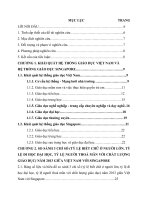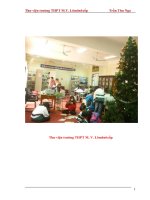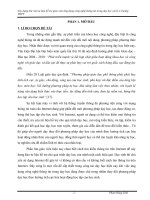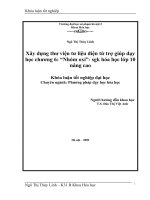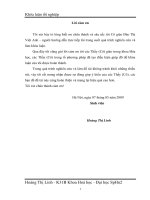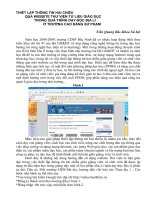- Trang chủ >>
- Luật >>
- Luật thương mại
mời dùngtrà toán học 4 lê hữu trình thư viện tư liệu giáo dục
Bạn đang xem bản rút gọn của tài liệu. Xem và tải ngay bản đầy đủ của tài liệu tại đây (592.83 KB, 16 trang )
<span class='text_page_counter'>(1)</span><div class='page_container' data-page=1></div>
<span class='text_page_counter'>(2)</span><div class='page_container' data-page=2>
I/ Warm-up :
<i><b>Activities </b></i>
<i><b>in the free time</b></i>
Go swimming Play soccer
Play video game
Go to the movies
Read book
Watch TV
</div>
<span class='text_page_counter'>(3)</span><div class='page_container' data-page=3></div>
<span class='text_page_counter'>(4)</span><div class='page_container' data-page=4>
Period 37 : <sub>Unit 6 : Language focus 2</sub>
<b>II/ Consolidation and practice :</b>
<i> </i>
<i>1/ Present progressive tense :</i>
<i>b.Form :</i>
+
<b>?</b>
<b></b>
<b>-S + be + V-ing + O</b>
<b>Be + S + V-ing + O ?</b>
<b>S + be(not) + V-ing + O</b>
<b>Yes, S + be</b>
<b>No, S + be(not</b>)
Ex: We are learning English.
Ex: We are not learning Math.
Ex: Are we learning Math?
No, we aren’t.
Ex: Are we learning English?
Yes, we are.
<b>I/ Warm-up :</b>
</div>
<span class='text_page_counter'>(5)</span><div class='page_container' data-page=5>
<b>II/ Consolidation and practice :</b>
<i>1/ Present progressive tense :</i>
<i>b. Form :</i>
<i>c. Complete the passage :</i>
It is six thirty in the evening. Lan
………... ……(do) her homework.
She ……….….. ……..(write) an English
essay. Mr. Thanh……….….. ………(read) a
newspaper and Mrs. Quyen
………..……...(cook) dinner. Liem
and Tien, Lan’sbrother,………..…….…………..
(play) soccer in the back yard.
Liem……….….….(kick) the ball and
Tien……….…(run) after it.
<i><b>is doing</b></i>
<i><b>is writing</b></i>
<i><b>is reading</b></i>
<i><b>is cooking</b></i>
<i><b>are playing</b></i>
<i><b>is kicking</b></i>
<i><b>is runing</b></i>
<i><b>is running</b></i>
<b>+</b>
<b>?</b>
<b></b>
<b>-S + be + V-ing + O</b>
<b>Be + S + V-ing + O ?</b>
<b>S + be(not) + V-ing + O</b>
<b>Yes, S + be</b>
<b>No, S + be(not)</b>
<b>I/ Warm-up</b>
:
</div>
<span class='text_page_counter'>(6)</span><div class='page_container' data-page=6>
Period 37 : <sub>Unit 6 : Language focus 2</sub>
<b>II/ Consolidation and practice :</b>
<i> </i>
<i>2/ This </i>
and
<i> that, these </i>
and
<i> those:</i>
<i>a. Usages :</i>
This
That
These + be + N (plural)
</div>
<span class='text_page_counter'>(7)</span><div class='page_container' data-page=7>
<b>II/ Consolidation and practice :</b>
<i> </i>
<i>2/ This </i>
and
<i> that, these </i>
and
<i> those:</i>
a. <i>Mom</i> : <i><b>This</b></i> room is untidy.
b. <i>Mom</i> : Put ………..bag away.
<i> Son</i> : ………..isn’t my bag. ……….is my bag.
c. Mom : Put ………dirty socks in the washing basket.
Son : ……….socks?
Mom : No. ……….socks on the bed.
d. Mom : Throw away ………..comics.
Son : But I like …………...…….comics, mom.
<i><b>this</b></i>
<i><b>That</b></i> <i><b>This</b></i>
<i><b>These</b></i>
<i><b>those</b></i>
<i><b>Those</b></i>
<i><b>these</b></i>
<i><b>those</b></i>
<i>b. Complete the dialogue.</i>
<b>I/ Warm-up</b>
:
</div>
<span class='text_page_counter'>(8)</span><div class='page_container' data-page=8>
Period 37 : <sub>Unit 6 : Language focus 2</sub>
<b>II/ Consolidation and practice :</b>
<i> </i>
<i>3/ Time :</i>
<i>a. Form :</i>
Ex: It is seven fifteen. (7h15’)
Ex: It is fifteen past/after seven. (7h15’)
Ex: It is fifteen to/of seven. (7hk15).
It is + hours + minutes.
It is + minutes + past/after + hours.
It is + minutes + to/of + hour.
</div>
<span class='text_page_counter'>(9)</span><div class='page_container' data-page=9>
<b>II/ Consolidation and practice :</b>
<i> </i>
<i>3/ Time :</i>
<i>a. Form :</i>
Ex: It is seven fifteen. (7h15’)
Ex: It is fifteen past/after seven. (7h15’)
Ex: It is fifteen to/of seven. (7hk15).
It is + hours + minutes.
It is + minutes + past/after + hours.
It is + minutes + to/of + hour.
<i>b. Write the correct time :</i>
Ba : What time is it?
Nam : It’s nine forty. It’s twenty to ten.
Lan : What time does the movie start?
Hoa : It starts at………<i><b><sub>seven fifteen/fifteen past seven</sub></b><b>.</b></i>
Mrs. Quyen: Will you be home for dinner tonight?
Mr. Thanh: No. I’ll be home at………<i>half past ten </i>
Miss Lien: Can you come to school early tomorrow?
Nam: Yes, Miss Lien, I’ll come at………<i>a quarter to seven </i>
</div>
<span class='text_page_counter'>(10)</span><div class='page_container' data-page=10>
Period 37 : <sub>Unit 6 : Language focus 2</sub>
<b>II/ Consolidation and practice :</b>
<i> </i>
<i>4/ Vocabulary (subjects) :</i>
Physical Education Geography Chemistry
English Math History
</div>
<span class='text_page_counter'>(11)</span><div class='page_container' data-page=11>
<b>II/ Consolidation and practice :</b>
<i> </i>
<i>5/ Adverbs of frequency :</i>
Always
Always
Usually
Usually
Often
Often
Seldom
Seldom
Never
Never
100%
0%
Mo
Mo
n
n Tue
Tue
s
s We
We
d
d Thur
Thur
s
s Fri
Fri SaSa
t
t Sun
Sun
Go cafeteria
Go cafeteria
Ride bike to school
Ride bike to school VV
Practice guitar after
Practice guitar after
school
school V
V VV VV VV VV VV VV
Do homework evening
Do homework evening VV VV VV VV VV
Play computer games
Play computer games VV VV VV
<i>* Write sentences about Ba</i>
a. Ba <i><b>never</b></i> goes to the cafeteria at lunch time.
b. Ba ...<i><b>seldom</b></i> rides his bike to school.
c. He ...<i><b>always</b></i> practices playing the guitar after school.
d. He ...<i><b>usually</b></i> does his homework in the evening.
e. He ...<i><b>often</b></i> plays computer games.
</div>
<span class='text_page_counter'>(12)</span><div class='page_container' data-page=12>
Period 37 : <sub>Unit 6 : Language focus 2</sub>
<b>II/ Consolidation and practice :</b>
<i> </i>
<i>6/ Making suggestion:</i>
<i>a. Form :</i>
<i>b. Examples :</i>
Lan : Let’s go swimming.
Hoa : OK.
Minh : Should we play table tennis.
Nam : I’m sorry, I’m busy.
<i>Suggestion</i>
<i>Suggestion</i>
Let’s
Let’s
Should we +
Should we + <b>VV</b>(without to)(without to)
Would you like to
Would you like to
Disagree (x)
Disagree (x)ss
- I’m sorry.I’m sorry.
- I can’t.I can’t.
- I’d like to, I’d like to,
Agree (v)
Agree (v)
- OK.OK.
- I’d love to.I’d love to.
- That’s great.That’s great.
Ba: Would you like to play basketball?
Nga: I’d love to.
</div>
<span class='text_page_counter'>(13)</span><div class='page_container' data-page=13>
<b>II/ Consolidation and practice :</b>
<i> </i>
<i>6/ Making suggestion:</i>
<i>a. Form :</i>
<i>b. Examples :</i>
<i>c. Write possible dialogues.</i>
Volleyball v Movies vVolleyball v Movies v
Soccer x My house x
Soccer x My house x
A : Let’s play volleyball.
B : I’d love to.
C : Would you like to play soccer?
D : I’m sorry, I can’t.
E : Should we go to the movies?
F : OK.
<b>G : Why don’t you go to my house to listen </b>
<b> to music?</b>
<b>H : I’d like to, but I have a lot of homework todo.</b>
<i>Suggestion</i>
<i>Suggestion</i>
Let’s
Let’s
Should we
Should we + + <b>VV</b>(without to)(without to)
Would you like to
Would you like to
Agree (v)
Agree (v)
- OK.OK.
- I’d love to.I’d love to.
- That’s great.That’s great.
Disagree (x)
Disagree (x)
- I’m sorry.I’m sorry.
- I can’t.I can’t.
- I’d like to, I’d like to,
but...
but...
</div>
<span class='text_page_counter'>(14)</span><div class='page_container' data-page=14>
Period 37 : <sub>Unit 6 : Language focus 2</sub>
<b>III/ Further practice:</b>
<i> </i>
<i><b>* Complete the sentences with the suitable words or phrases</b></i>
1/
………don’t you come to my house ?
Let’s go
2/ What about
……….Halong Bay ?
3/ Would you like
………badminton ?
4/Children should
………to bed early.
5/ That’s a good
……….? Let’s go to the beach
<i> </i>
<i><b>Why</b></i>
<i><b>visiting</b></i>
<i><b>to play</b></i>
<i><b>go</b></i>
<i><b>( / Let’s / What ).</b></i>
<i><b>(to visit / visit / )</b></i>
<b>( </b><i><b>play / / playing</b></i><b> )</b>
<i><b>( / to go / going)</b></i>
<b>I/ Warm-up</b>
:
<b>II/ Consolidation and practice :</b>
</div>
<span class='text_page_counter'>(15)</span><div class='page_container' data-page=15></div>
<span class='text_page_counter'>(16)</span><div class='page_container' data-page=16></div>
<!--links-->



